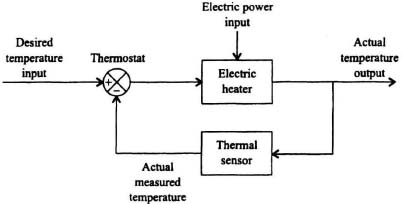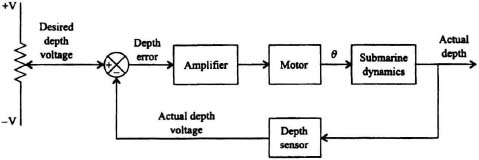1.6. ILLUSTRATIVE PROBLEMS AND SOLUTIONS
This section provides a set of illustrative problems and their solutions to supplement the material presented in Chapter 1.
I1.1. Draw a block diagram representation of a thermostatically controlled electric oven in the kitchen of a home.
SOLUTION:
Figure I1.1
I1.2. The control of a nuclear reactor is a very interesting control-system problem. The rate of fission is controlled by rods inserted into the radioactive core. The position of the rods inserted into the core determines the flow of neutrons. The automatic control of the rod position determines the fission process and its resulting heat which is used to generate steam in the turbine. If the rods are pulled out completely, an uncontrolled fission occurs; if the rods are fully inserted into the core, the fission process stops. Draw a block diagram representation for the control of the radiation of the nuclear reactor system shown.
Figure I1.2i
Figure I1.2ii
I1.3. The automatic depth control of a submarine is an interesting control system problem. Suppose the captain of the submarine wants the submarine to “hover” at a desired depth, and sets the desired depth as a voltage from a calibrated potentiometer. The actual depth is measured by a pressure transducer which produces a voltage proportional to depth. The following figure illustrates the problem, where the actual depth of the submarine is denoted as C. Any differences are amplified which then drives a motor that rotates the stern plane actuator angle θ in order that the stern plane rotation reduces the depth error of the submarine to zero. Draw the block diagram representation of the automatic depth control system of the submarine.
Figure I1.3i
SOLUTION:
Figure I1.3ii
I1.4. An elevator-position control system used in an apartment building is a very interesting control-system problem. Draw the block diagram representation of an elevator control system in a three-floor building which obtains the desired floor reference position as a voltage from the elevator passenger pressing a button on the elevator, and compares this voltage with a voltage from a position sensor that represents the actual floor position the elevator is at. The difference is an error voltage which is amplified and connected to an electric motor that positions the elevator car to the desired floor selected.
SOLUTION:
Figure I1.4






